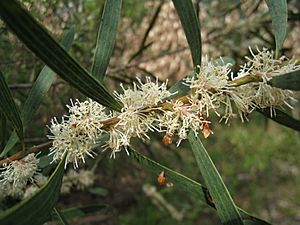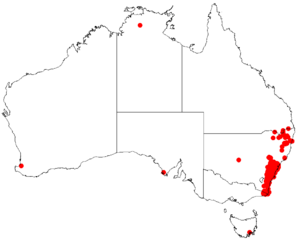Finger hakea facts for kids
Quick facts for kids Finger hakea |
|
|---|---|
 |
|
| Scientific classification | |
| Genus: |
Hakea
|
| Species: |
dactyloides
|
 |
|
| Occurrence data from AVH | |
The finger hakea, also known as Hakea dactyloides, is a cool plant found mostly in southeastern New South Wales, Australia. It's a pretty shrub or small tree that would look great in a garden. It grows lovely cream-white flowers.
What it Looks Like
The finger hakea is a bushy shrub or small tree. It usually has one main stem and grows about 2.4 to 4.5 meters (8 to 15 feet) tall. Its small branches are smooth and light-colored. When the plant flowers, these branches have short, soft hairs.
The leaves are long and narrow. They are widest in the middle and can be 3.9 to 13 centimeters (1.5 to 5 inches) long. They are about 5 to 14.5 millimeters (0.2 to 0.6 inches) wide. These mid-green leaves get narrower towards the end, forming a sharp point. They have three clear lines (veins) running along them.
The plant's flowers grow in groups of 20 to 38. These white flowers appear on a short stem. Each flower has cream-white sepals and petals. The style (a part of the flower) is about 4 to 6.5 millimeters (0.16 to 0.26 inches) long.
After flowering, the plant produces fruit. These fruits are egg-shaped and a bit bumpy, with a slight curve. They are about 2.5 to 3.5 centimeters (1 to 1.4 inches) long and 1.7 to 2.3 centimeters (0.7 to 0.9 inches) wide. Each fruit ends with a short, sharp point. You can often see small white flowers, sometimes with a pink tint, growing in clusters along the branches from October to November.
Naming the Finger Hakea
The finger hakea was first described in 1788 by a scientist named Joseph Gaertner. He called it Banksia dactyloides back then. Later, in 1800, another scientist, Antonio Jose Cavanilles, described it again. This time, he gave it the name Hakea dactyloides.
The word "dactyloides" comes from Greek. "Dactylos" means "finger," and "-oides" means "resembling." So, "dactyloides" means "finger-like." This name probably refers to the shape of the plant's leaves, which might look a bit like fingers!
Where it Grows
The finger hakea is found in many places in Australia. It grows along the Central Coast and South Coast of New South Wales. You can also find it in the Tablelands of New South Wales, including the Central Western Slopes, and in north-eastern Victoria.
This plant prefers to grow on slopes, ridges, and near water. It likes sandy soil in a type of forest called sclerophyll forest. Sclerophyll forests have plants with hard, tough leaves that help them survive dry conditions. The finger hakea is a strong and fast-growing plant that can handle many different environments.
See also
 In Spanish: Hakea dactyloides para niños
In Spanish: Hakea dactyloides para niños

